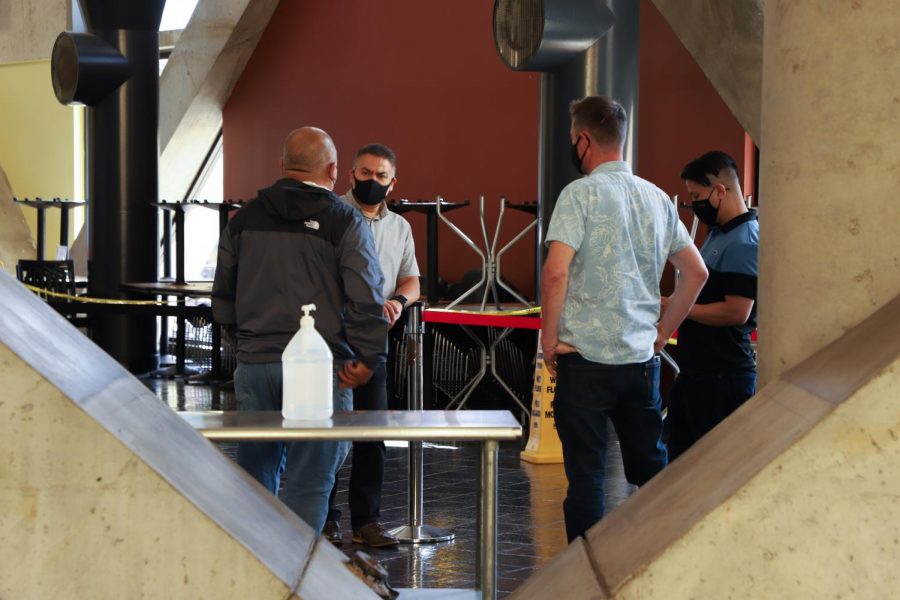The once popular Nizario’s Pizza in the Cesar Chavez Center left owner Abdul Awadalla’s pockets just as empty as the establishment, after handing out approximately 2,000 free pies in the first five days of school to entice hungry stomachs.
Despite all the dough, Awadalla found himself seriously considering closing down two months into the semester.
In normal semesters, Awadalla said that Fridays were Nizario’s slowest days, as people would often leave campus ahead of the weekend. Now, Awadalla said that they are pulling in a fraction of the sales. “We were hoping that everyday would be like a Friday, which is about half of a normal day, but it’s been not even close to that,” Awadalla said.
Although he accepted the inevitability of losing money, he was not prepared to bow out, on account of the pandemic’s effects.
Despite initial doubts, Nizario’s Pizza is one of the vendors on campus that will stick out the return to indoor dining, which is set for Oct. 4. Awadalla is one of a handful of other business owners still uncertain of how much revenue this move will bring in, keeping these businesses afloat.
Andrew Lok, the retail and commercial services manager with UCORP – the organization that oversees all vendors on campus – said that it will prioritize the plaza level in this plan’s initial phase with limited seating, with full capacity being the ultimate goal.
The restaurateur initially said he would be closing the doors to Nizario’s on Sept. 30, unless there was a drastic shift in sales. With a bleak forecast for such a prospect and a location that is nestled in a corner hidden to immediate student view according to Nizario, the decision to close stood unwavering up until Friday, when Awadalla told Xpress he had changed his mind.
Awadalla is also owner of Crave Subs –a sandwich shop next to Nizario’s Pizza– which did not reopen because of his uncertainty regarding student attendance and loss of profit. He plans to re-open Crave Subs next semester.
That same sentiment of uncertainty Awadalla felt is a feeling prevalent amongst many business owners on campus after being struck with health restrictions in 2020 in combination with other factors on campus.
“I feel like we’re seeing most of the world or most of the U.S. opening back up, but it seems like the CSU systems have been too slow to reopen and get things going again,” Awadalla said.
SF State is proceeding with its phased return as specified by mandates from the San Francisco Department of Public Health, which stated on its website that as of March 16, 2020, the prohibition of large gatherings was rescinded.
In closely following all SFDPH safety guidelines, UCORP is creating a plan for all vendors on campus to provide a phased return to indoor seating for restaurants who choose to open for Fall 2021.
“There looks to be support around the program,” Lok said. “It’s just a matter of making sure all the logistics can be handled in a way that this can be provided in a safe environment, and that’s kind of the main driving factor in terms of getting it implemented.”
He was unable to provide specifics of the plan, as it is still being pieced together, but did say that all indoor seating areas will require physical proof of vaccination upon entry.
One of the businesses found in that plaza level is Girasol Taqueria – the only Latino owned business on campus which, like Nizario’s Pizza, decided to open the first day of the semester.

“I didn’t know what to expect. They had told us it would be about 20% to 30% students back, and it doesn’t look like it,” owner Marco Ballesteros said about his expectations for reopening. “Not being able to eat inside the building has definitely stopped students’ interest in coming and grabbing a bite to eat from any restaurant on campus.”
For Ballesteros, the plan currently in the works sounds like a hopeful attempt to aid the situation all owners have dealt with and are hopeful for its effect. Girasol, which previously employed 17 individuals, is now down to seven workers, he said.
Ballesteros also reported that his sales are at about 15% to 20% from before the pandemic.
“I hope the indoor dining works out for the university and for us and to have people come back, and I say this for all businesses because if one vendor suffers we all suffer,” Ballesteros said.
Ryan Acebay, a second year graduate student who works as a manager at Rack-N-Cue, expressed feeling guilty about what he’s had to do because of the lack of indoor seating.
”It’s only natural for people to want to walk in here with food or drinks, we are next to a food court and I have to sort of shoo them out, which feels so uncomfortable to me,” he said.
In his free time before the pandemic, Acebay enjoyed having an IPA at SF State’s on-campus bar, The Pub, another one of the businesses that did not open this semester.
In June 2020, Ferras Jweinat flicked the lights off to The Pub without knowing that would be the last time for months on and to this day, the owner stated he does not have a set date for a return.
The bar owner’s experience resembled that of Ballesteros to some extent but mirrored Awadalla’s experience in that the decline in student population left slim plausibility for survival during the Fall 2021 semester across all business aspects.
“If the student population on campus is not higher, I anticipate us being closed throughout the rest of the year and not coming back until the spring of 2022,” Jweinat said.
Jweinat’s love for the business of 20 years and the greater SF State community enabled the owners’ high hopes in reopening on Oct. 4, but they were not nearly enough for him to turn the lights back on and keep them on successfully.
“What this all comes down to is the cost of doing business and there is a significant cost factor we will face,” Jweinat said.
In a report released by The National Restaurant Association, data showed that by the end of 2020, there was an overall decrease of $240 billion from expected levels of overall restaurant generated revenue.
This included the sales shortfall at bars and restaurants, plus a sharp reduction in spending at food service operations in sectors such as lodging, education, health care and retail.
Jweinat was unable to provide numbers pertaining to The Pub’s monetary loss since its last day of operation, but he did say he was facing unique challenges as they did not offer food items.
For Jweinat, the 13,000 students on campus this semester from the more than 25,000 overall enrolled stated by President Lynn Mahoney in the 2021 convocation speech, played a powerful and direct role on the businesses financial viability.
Until the physical population on campus resumes, Jweinat does not foresee operations at The Pub to be up to customary standard.
In looking to make the best decision for the financial stability of his family’s operation, Jweinat would like to wait for a more viable number of students. He plans to observe the effect of indoor seating on Oct. 4 before making a decision.
More specifically, Jweinat’s observations on Monday will consist of overlooking businesses’ customer flow and progress for at least the first two weeks as a means to carry on making strategic business decisions.
“The heart and soul of this place is having that student energy back and we dearly miss and need that,” Jweinat said.
For Graharm Muckenfuss, a 2019 SF State alum, like Acebay, the bar was a place where he would go to unwind after class and watch games with friends who liked to talk about sports after a long day.
”I’m very glad it’s going to be coming back at least to some capacity and at a date that is safe for it to reopen for everyone because it’s a nice place to have on campus,” Muckenfuss said.
Even with the uncertainty in the horizon, Jweinat does not forecast a permanent closure for The Pub at SF state. Instead, he is optimistic for what is yet to come.
“It’s like knowing the unknown right, and that’s kind of where we are at right now, but I am pessimistically optimistic, as I like to say,” Jweinat said.
Each party involved will review the specifics for the plan as it continues to unfold. Adherence to SFPDH will be upheld until further notice.










